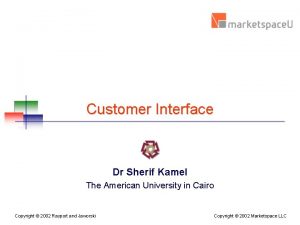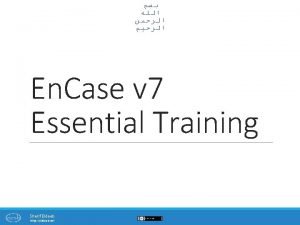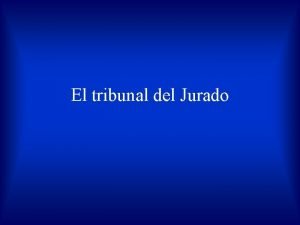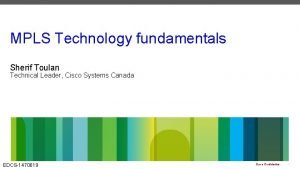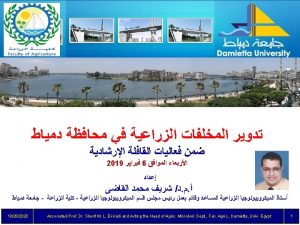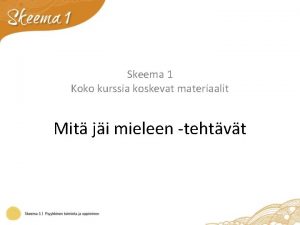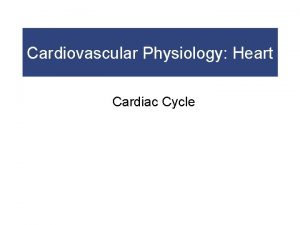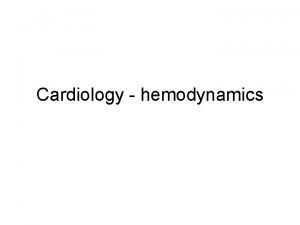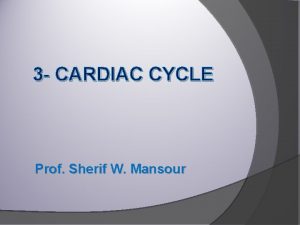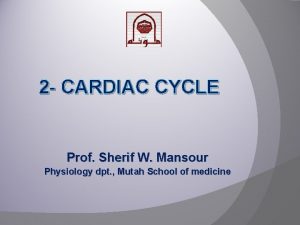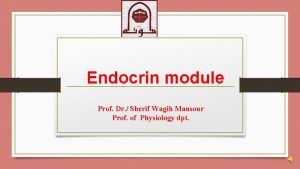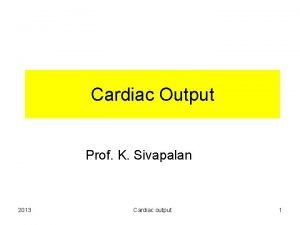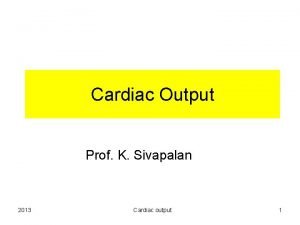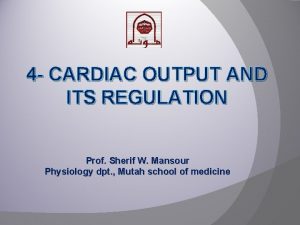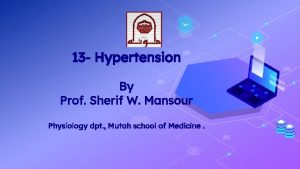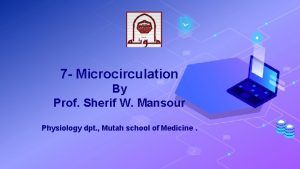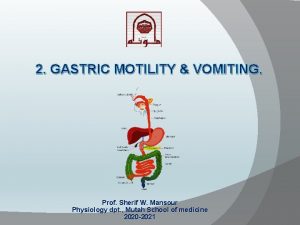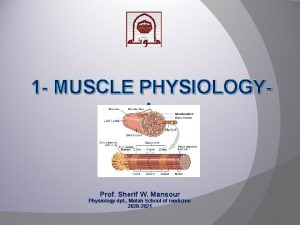5 CARDIAC OUTPUT Prof Sherif W Mansour Cardiac











- Slides: 11

5 - CARDIAC OUTPUT Prof. Sherif W. Mansour

Cardiac output It is the volume of blood ejected from each ventricle per minute. The usual resting values for adults are 5 L/min, or approximately 8% of body weight per minute. Cardiac output varies with the body’s state of activity. Vigorous exercise increases CO to as much as 21 L/min in a person in good condition and up to 35 L/min in athletes. Cardiac output / body surface area = cardiac index (CI). CI = COP/m 2 = 5 L / 1. 73 m = 3. 2 L/min/m 2. If we consider the surface area of adult male weighted 70 Kg = 1. 73 m 2. Cardiac output is the product of heart rate (HR) and stroke volume (SV), the volume of blood ejected with each beat: CO = SV Х HR CO = 70 x 70 = about 5000 ml/min (5 l/min). The difference between the maximum and resting cardiac output is called cardiac reserve. Ejection fraction (EF) is a commonly used measure of cardiac performance. It is the ratio of stroke volume to end diastolic volume (EDV), expressed as %: EF = (SV/EDV) % Ejection fraction is normally more than 55%.

Cardiac output in various conditions A- Cardiac output is not changed during: - Sleep - Moderate changes in environmental temperature. B-Cardiac output is increased in: 1 - Excitement: increase COP by about 50 -100% due to sympathetic stimulation. 2 - Exposure to extremes of temperature: -In high temperature due to skin vasodilatation. -In very low temperature also COP increased due to increase muscle tone which increases venous return → ↑COP. 3 - Eating: in the first few hours after eating due to increase GIT blood flow. 4 - Exercise: exercise can increase COP up to 700% in trained athletes 5 - Pregnancy: due to increase uterine blood flow and placental arteriovenous shunt.

C- Cardiac output is decreased in: 1 - Sitting or standing from lying down decrease COP by 20 30%. However under normal condition immediate compensation occurs by constriction of veins→ increase venous return→ increase COP. 2 - Marked arrhythmia (tachycardia or bradycardia). -In tachycardia: COP is decreased due to shortening of the diastolic period in which cardiac filling occur. -In bradycardia: although the SV is increased it cannot compensate for the decreased HR. 3 - In all conditions which destroy the cardiac muscle fibers.

REGULATION OF CARDIAC OUTPUT -This is carried out through the modification of either the SV or heart rate or both. I-Contractility: Increase the force of cardiac muscle contractility depends on two independent mechanisms (intrinsic and extrinsic) 1 - Intrinsic regulation: -This mechanism affects only the SV by affecting contractility and include heterometric and homeo-metric autoregulation. (a) Heterometric autoregulation (Starling law): • It is the ability of the cardiac muscle to increase its force of contraction secondary to increase in the EDV (preload). Increased contraction leads to increase in SV and COP. • This mechanism starts about 30 seconds after increase in venous return (for example in muscular exercise) i. e. At the beginning of exercise there is increase in venous return but the COP is not increased so the heart is dilated to accommodate excess venous return EDV is increased force of contraction SV and COP. • This mechanism has physiological limitations because overstretch of the myocardial fibers leads to weakening of the contraction and decrease in SV and COP.

b) Homeometric autoregulation: • Means increase the force of contraction without increase in EDV. • It starts 2 -5 minutes after increase in the venous return after heterometric autoregulation, the EDV starts to return gradually to its normal level due to rapid pumping of the blood , however, the force of contraction is still high and so the SV is still elevated in spite of normal or slightly decreased EDV so the SV is elevated at the expense of ESV. • This mechanism occurs in prolonged exercise. • This mechanism of increased contractility in homeometric autoregulation is the increase in intra-ventricular pressure and aortic pressure (increasing coronary flow) produced by increase in EDV and increased contractility during heterometric auto-rgulation. • The homeometric autoregulation is present as long as the venous return is elevated. • This mechanism is lost in cardiac failure and the heterometric autoregulation becomes the only mechanism controlling the CO in cardiac failure (cardiac failure: failure of the heart to pump enough blood to satisfy the body needs) However, in certain situation e. g muscular exercise, the heterometric and homeometric auto-regulations operate at the same time for a long time to maintain marked increase in SV although the heterometric mechanism starts first.

2 -Extrinsic regulation: This mechanism affect both SV and HR through: A- Autonomic nervous system: ●Sympathetic nervous system increases CO due to: 1 -Increase HR (positive chronotropic effect ) 2 -Increased contractility (positive inotropic effect) 3 -Venoconstriction which increases venous return and filling of the heart. ●Parasympathetic N. S. decreases CO through decreasing HR and minimal effect on myocardial contractility. B- Chemical Factors: - Chemicals: Increase C. O. leads to Hyper-effective heart: • Catecholamines increases c. AMP that increase Ca++influx. • Digitalis (Digoxine) increases C. O. P in heart failure by increase release of Ca++ and force of contraction. • Thyroxin increases HR and force of contraction via stimulation of the metabolic rate of SAN and cardiac muscle and enhances sympathetic effect on the heart. • Xanthines (caffeine) inhibits phosphodiestrase enzyme which hydrolyze c. AMP increasing Ca++influx

- Chemicals that Decrease C. O leading to Hypo-effective heart: • Hypoxia, hypercapnia (increased CO 2), acidosis, electrolytes imbalance. • Ischaemia and bacterial toxins (as typhoid). • Quinidine (cardiac depressant drug) & chloroform. • Severe malnutrition as anemia and vitamin B deficiency (Beri). II. Heart Rate (HR): Provided that venous return is kept constant: • Mild and moderate change in heart rate (60 - 160 beat/ minute) does not affect the CO but affect SV inversely. e. g. increase HR produces shortening of the diastolic period decreasing the filling of the ventricle, and decreases SV and vice versa. • Marked increase in HR decreases the CO due to marked shortening of the diastolic period leading to: 1 -Decrease filling of the ventricle, decrease EDV that decreases SV and COP.

2 - Decrease the time of main coronary flow causes decrease in the force of contraction and consequently decrease SV and COP. - The increase in the heart rate can not compensate for the marked decrease in stroke volume. • Marked decrease in heart rate (< 60 beat/min), although increases the time of diastole and increases the filling of ventricle and SV; the increased SV cannot compensate for marked decrease in HR. This occurs when the ventricle beats by its idioventricular rhythm (25 -40 heart/minute). III. Mean Arterial Blood Pressure (Afterload): After-load is the force against which the heart is contracting (aortic pressure). When the mean arterial blood pressure is raised, the heart pumps less amount of blood than it receives for several beats so blood accumulates in the ventricles and the size of the heart increases. The distended heart contracts more forcefully and the CO returns to its previous level. Conversely, when the mean arterial blood pressure is reduced, CO rises transiently but the size of the heart decreases so the CO fall to its previous constant level.

IV. Venous Return (VR) or Preload: It is the most important factor controlling the COP as the heart adjust it self in order to keep COP equal to venous return. ● Increase VR increases EDV that increase SV (Heterometric autoregulation) ● Increase VR increases HR. So increase in both SV and HR leads to increase CO in order to maintain balance between VR and CO.

Thank You

